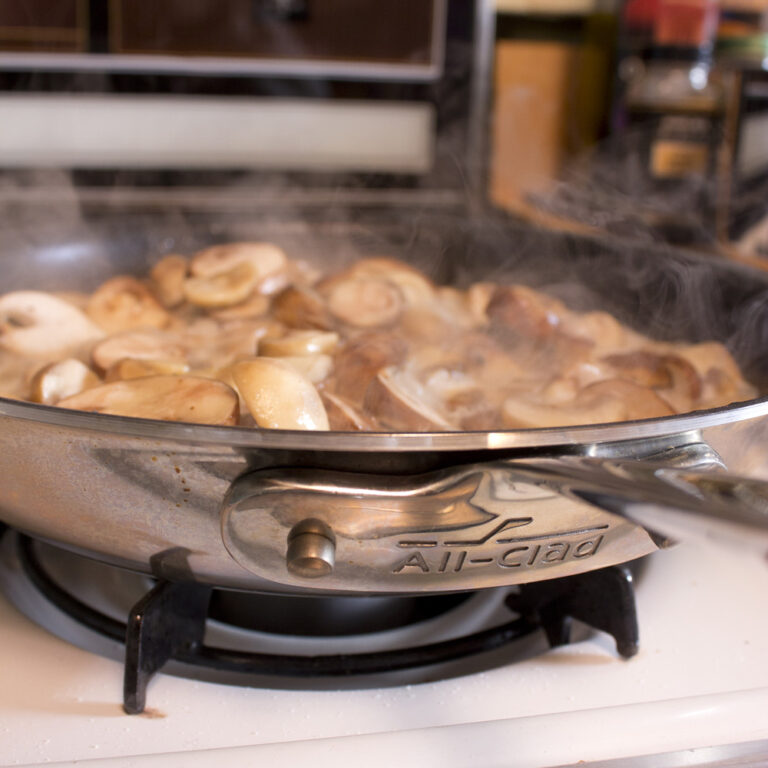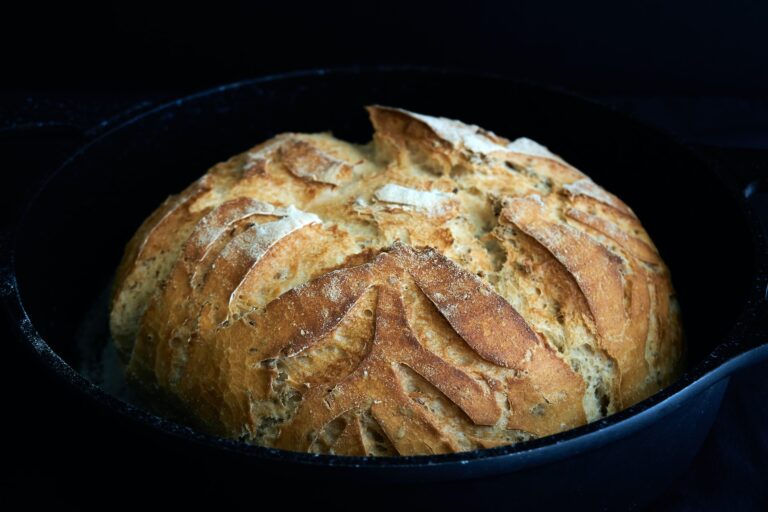I’ve always been fascinated by the rich and diverse world of culinary tools.
One particular item that has caught my attention is the paella pan.
Have you ever wondered what makes these pans so special? In this article, we’ll explore the history, types, materials, and benefits of cooking with paella pans.
I’ll also share tips on seasoning, cleaning, and cooking techniques, as well as where to find authentic paella pans.
Let’s dive in and discover the secrets of this iconic Spanish cookware.
Key Takeaways
- Paella pans have evolved over time, from the original thin, flat iron ‘paellera’ to wider and shallower designs for better heat distribution.
- Paella pans come in various materials such as stainless steel and carbon steel, with each material offering its own advantages.
- The size and capacity of the paella pan should be chosen based on the number of servings and the size of the stovetop burner.
- Cooking with a paella pan offers versatility, even heat distribution, large capacity, and easy cleaning, making it convenient for preparing meals for a large group.
The History of Paella Pans
You might be curious about the history of paella pans and how they have evolved over time. Well, let me tell you a little bit about it.
Paella, a traditional Spanish dish, has been cooked for centuries in Spain. The original paella pan, known as a ‘paellera,’ was made from thin, flat iron and had two handles for easy transportation.
As time went on, the design of the paella pan evolved. Cooks realized that a wider and shallower pan allowed for better heat distribution and more even cooking. This led to the development of the iconic wide, flat-bottomed paella pan that we know today.
Nowadays, paella pans come in various materials, such as stainless steel and carbon steel, and can be used on different heat sources like stovetops and grills.
Different Types of Paella Pans
There are various types of paella pans available, each with its own unique features. When it comes to choosing the right pan for making paella, it’s important to consider the size, material, and shape.
The most common types of paella pans are made of carbon steel, which heats up quickly and evenly. These pans are perfect for achieving that signature crispy bottom layer of rice known as ‘socarrat.’ Another popular option is the stainless steel paella pan, which is durable and resistant to rust. If you prefer a nonstick option, there are also paella pans with a nonstick coating.
Additionally, some pans have a flat bottom, while others have a slight indentation in the center, allowing for even heat distribution. Ultimately, the choice of paella pan depends on your personal preference and cooking style.
Materials Used in Paella Pans
If you’re looking for a durable and rust-resistant option, stainless steel is a great material for your paella pan. It not only withstands high temperatures, but it also provides even heat distribution for a perfectly cooked paella. Here are four reasons why stainless steel is an excellent choice:
- Durability: Stainless steel is known for its strength and long-lasting performance. It can withstand frequent use and is resistant to dents and scratches.
- Rust-resistant: Unlike other materials, stainless steel is highly resistant to rust and corrosion. This ensures that your paella pan remains in great condition even after multiple uses and washes.
- Even heat distribution: Stainless steel pans have excellent heat conduction properties, which means your paella will cook evenly throughout. No more hot spots or unevenly cooked rice!
- Easy to clean: Stainless steel is non-porous, making it easy to clean and maintain. Simply wash it with warm, soapy water, and it’ll look as good as new.
With all these benefits, it’s no wonder stainless steel is a popular choice for paella pans.
Size and Capacity of Paella Pans
When choosing the size and capacity of your paella pan, consider how many servings you want to make and the size of your stovetop burner. It’s important to have a pan that is large enough to accommodate all the ingredients, but also fits comfortably on your burner.
If you’re cooking for a small group, a 12-inch pan should be sufficient, allowing you to make about 4 to 6 servings. However, if you’re hosting a larger gathering, you may need a bigger pan, such as a 15 or 18-inch, which can serve up to 10 or more people.
Additionally, the depth of the pan is important for even heat distribution and cooking the rice properly. So, choose a pan with a depth of at least 2 inches to ensure delicious results.
Benefits of Cooking With Paella Pans
Cooking with paella pans offers the convenience of preparing a delicious one-pot meal that can serve a large group of people. I love using my paella pan because it saves me time and effort in the kitchen.
Here are four benefits of cooking with paella pans:
- Versatility: Paella pans are not just limited to making paella. You can use them to cook a variety of dishes like stir-fries, risottos, and even desserts.
- Even Heat Distribution: Paella pans are made of thick, durable materials that distribute heat evenly. This ensures that your food cooks uniformly, preventing any hot spots or uneven cooking.
- Large Capacity: Paella pans are designed to accommodate large quantities of food, making them perfect for entertaining or feeding a crowd. You can easily cook enough food to serve 10-12 people in a single pan.
- Easy to Clean: Most paella pans are non-stick or have a seasoned surface, making them easy to clean. A simple rinse or wipe with a soft cloth is usually enough to remove any leftover food residue.
Overall, cooking with a paella pan is a convenient and efficient way to prepare delicious meals for a large group of people.
How to Season a Paella Pan
To season your paella pan, you’ll want to start by washing it with warm, soapy water. This will remove any dirt or debris that may be on the surface. After rinsing it thoroughly, dry it with a clean towel.
Next, apply a thin layer of oil to the inside of the pan. I like to use olive oil because it adds a nice flavor to the paella. Make sure to coat the entire surface evenly.
Then, heat the pan over medium heat for about 5 minutes. This will help the oil penetrate the metal and create a non-stick surface.
Once the pan has cooled, wipe away any excess oil. Now your paella pan is seasoned and ready to use for your next delicious meal!
Maintaining and Cleaning Paella Pans
If you want your pan to last, it’s important to properly clean and maintain it. Here are four key steps I follow to ensure my paella pan stays in great shape:
- Rinse with warm water: After cooking, I always start by rinsing my pan with warm water. This helps remove any food residue and prevents it from sticking to the pan.
- Use a non-abrasive sponge: To avoid scratching the surface of the pan, I use a non-abrasive sponge or cloth to gently clean it. This helps maintain the non-stick properties of the pan.
- Avoid harsh detergents: Harsh detergents can damage the pan’s coating, so I always opt for mild dish soap or a specialized pan cleaner. This ensures the longevity of the pan.
- Dry thoroughly: After washing, I make sure to dry the pan thoroughly to prevent any moisture from causing rust or corrosion. I usually air-dry it or use a clean towel to pat it dry.
Cooking Techniques for Paella Pans
After learning about how to maintain and clean paella pans, I’m excited to delve into the cooking techniques for these versatile pans.
When it comes to cooking paella, there are a few key techniques that can make all the difference in achieving that perfect, flavorful dish.
First and foremost, it’s important to evenly distribute the heat by using a burner that covers the entire bottom of the pan. This ensures that the rice cooks evenly and doesn’t stick to the bottom.
Another important technique is to layer the ingredients properly. Start with the sofrito, then add the rice, broth, and finally the meats or vegetables. This layering technique allows the flavors to meld together beautifully.
Lastly, resist the temptation to stir the paella once the ingredients are in the pan. Instead, let it cook undisturbed to develop that coveted crispy bottom layer known as the socarrat.
Mastering these cooking techniques will surely elevate your paella game.
Where to Buy Authentic Paella Pans
When you’re looking for an authentic paella pan, consider checking out specialty kitchen stores or online retailers that specialize in Spanish cookware. I personally love browsing through these options because they offer a wide range of paella pans, ensuring that I can find the perfect one for my paella cooking needs.
Here are four reasons why I recommend buying authentic paella pans from these sources:
- Quality: Specialty stores and online retailers that specialize in Spanish cookware are dedicated to providing high-quality products. This means that the paella pans they offer are made with durable materials and are designed to withstand high heat and frequent use.
- Variety: These stores and retailers offer a variety of paella pans in different sizes and materials, allowing you to choose the one that suits your preferences and cooking style. Whether you prefer a traditional carbon steel pan or a modern stainless steel one, you’ll find plenty of options to choose from.
- Authenticity: By purchasing from these sources, you can be confident that you’re getting an authentic paella pan that is true to the traditional Spanish design. This ensures that your paella will turn out just like the ones made in Spain.
- Expertise: Specialty kitchen stores and online retailers that specialize in Spanish cookware often have knowledgeable staff or provide detailed product information on their websites. This can be helpful when selecting the right paella pan for your needs, as they can provide guidance and answer any questions you may have.
Overall, shopping at specialty kitchen stores or online retailers that specialize in Spanish cookware is a great way to find an authentic and high-quality paella pan for your cooking adventures.
Conclusion
In conclusion, paella pans are essential tools in cooking authentic paella dishes. The history of paella pans dates back centuries, and there are various types and materials to choose from.
Their size and capacity can accommodate different serving sizes, making them versatile for any occasion. Cooking with paella pans provides even heat distribution and enhances the flavors of the dish.
Proper seasoning, maintenance, and cleaning ensure their longevity. Whether you’re a professional chef or a home cook, finding an authentic paella pan will elevate your culinary experience.


